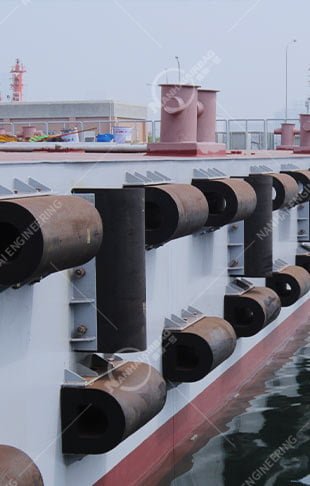Les défenses de bateau sont-elles toutes gonflables ?
05/05/2025Quels sont les matériaux utilisés pour les défenses marines ? Un guide complet
05/06/2025Quels sont les différents types de défenses de navire ?
Ship fenders play a critical role in protecting vessels, docks, and marine structures from damage during berthing and mooring. But why should you care about choosing the right ones? Let’s break it down.
Without proper fenders, even a minor collision can lead to expensive hull repairs, operational delays, and environmental risks. Picture this: A cargo ship slams into a pier because its fenders fail—now you’re facing thousands in damages and potential lawsuits. That’s why selecting the best ship fenders isn’t just a good idea—it’s an urgent necessity for safety and efficiency.
Extraits en vedette
What are the main types of ship fenders?
The most common types include rubber fenders (cylindrical, D-shaped, cone, arch fender, element fender), pneumatic fenders, foam-filled fenders, and inflatable boat bumpers, each suited for different vessel sizes and docking conditions.
How do pneumatic fenders work?
Pneumatic fenders of ships act like giant air cushions, absorbing impact through compression. They’re perfect for heavy-duty use, such as oil tankers and cargo ships.
Where can I buy reliable ship fenders?
If you need buy défenses de navire, NANHAI fender ships factory suppliers offer durable options for both commercial and recreational marine use.
A Deep Dive into Ship Fender Types
1. Rubber Fenders
Ailes en caoutchouc dominate the market because they last long and adapt to various marine conditions. Manufacturers produce them in multiple shapes:
- Défenses cylindriques: The go-to choice for general marine protection. Défenses cylindriques are inexpensive and easy to install.
- Défenses de type D: Their flat side ensures better dock contact. Ailes de type D can be directly fixed to port or wharf structures with bolts and require almost no maintenance, easily adapting to harsh environments.
- Défenses à cône: High-performance design with big deflection, supporting large panels and excelling in angle compression—maintaining full performance even under 10-degree loads. Available in wide-ranging sizes to meet diverse design needs.
- Arch Fenders: Arched fenders have low maintenance costs and are easy to install. They are widely used on small and medium-sized ships or are used in combination with cylindrical fenders to form fender systems.
- Défenses de l'élément: Le élément d'aile absorbs energy through rubber legs formed by one-piece stamping and can minimize kickback to the greatest extent. Flexible installation, suitable for small Spaces with limited installation.






2. Pneumatic Fenders
Pneumatic fenders of ships work like oversized airbags, cushioning massive impacts. Offshore industries and ship-to-ship(STS) transfers rely on them because they handle extreme forces effortlessly. Customers can install truck tire net or aircraft tire net as needed to further increase the lifespan.

3. Foam-Filled Fenders
These défenses remplies de mousse use closed-cell foam to stay buoyant and resist water damage. Foam fenders can function normally even if they are damaged due to their structure. Marinas and boat owners prefer them for their balance of strength and weight.

4. Donut Fenders
Donut fenders are primarily used at the corners of docks or ports to protect structural safety. Additionally, they are often brightly colored, making them highly visible. As a result, they are also commonly installed at narrow dock entrances, where they serve as effective guides for vessels.

Why the Right Fender Choice Matters?
Picking the wrong fenders for ships can cause:
- Faster wear and tear on vessels and docks
- More frequent replacements, driving up costs
- Safety hazards in rough waters
Whether you need ship fenders for sale for a busy port or the best boat bumpers for weekend sailing, understanding your options saves money and prevents accidents.
FAQ
What’s the primary use of pneumatic fenders on ships?
They handle high-impact scenarios like ship-to-ship(STS) transfers and offshore mooring.
How do I pick the best boat bumpers?
Match them to your boat size, docking environment, and material needs (rubber, foam, or pneumatic).
Where can I find a dependable fender ships factory?
Seek manufacturers with marine industry experience and ISO 17357 certifications. Nanhai has over 20 years of experience in the production of Marine fenders, and its products fully comply with the ISO 17357 standard.
What’s better—D-shaped or cylindrical fenders?
D-shaped fenders offer better dock contact, while cylindrical ones provide uniform protection.
Do foam-filled fenders resist saltwater damage?
Yes, high-quality closed-cell foam won’t corrode and stays buoyant in saltwater. A new type of spraying polyurethane (polyurea) technology has been invented by NANHAI to make the surface of the foam filled fender anti-corrosive and scratch-resistant. It can adapt to various harsh weather environments. Customer can customize the coating thickness and color according to their requirement.
Réflexions finales
Choisir le bon fenders for ships prevents costly damage and keeps operations running smoothly. Whether you need rugged défenses pneumatiques or convenient best boat bumpers, the right choice ensures long-term protection.
Ready to upgrade your marine fenders? Explore top suppliers today for the best solutions!
